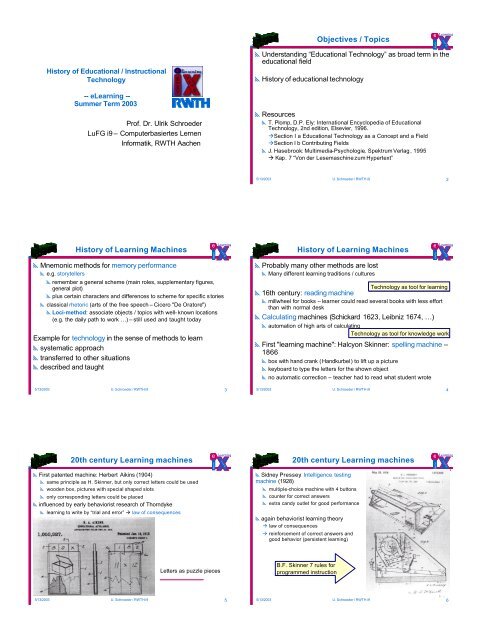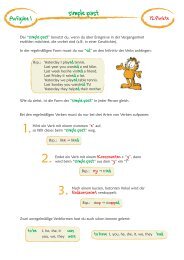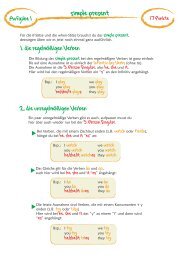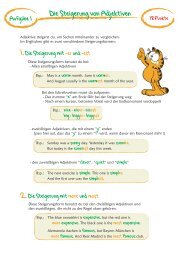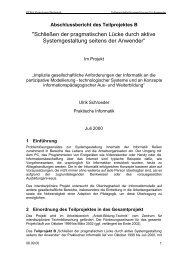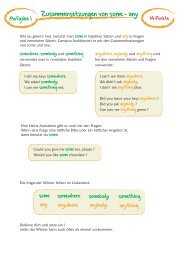Objectives / Topics History of Learning Machines History of ... - LuFG i9
Objectives / Topics History of Learning Machines History of ... - LuFG i9
Objectives / Topics History of Learning Machines History of ... - LuFG i9
You also want an ePaper? Increase the reach of your titles
YUMPU automatically turns print PDFs into web optimized ePapers that Google loves.
<strong>History</strong> <strong>of</strong> Educational / Instructional<br />
Technology<br />
-- e<strong>Learning</strong> --<br />
Summer Term 2003<br />
Pr<strong>of</strong>. Dr. Ulrik Schroeder<br />
<strong>LuFG</strong> <strong>i9</strong> – Computerbasiertes Lernen<br />
Informatik, RWTH Aachen<br />
<strong>History</strong> <strong>of</strong> <strong>Learning</strong> <strong>Machines</strong><br />
yMnemonic methods for memory performance<br />
ye.g. storytellers<br />
e <strong>Learning</strong><br />
yremember a general scheme (main roles, supplementary figures,<br />
general plot)<br />
yplus certain characters and differences to scheme for specific stories<br />
yclassical rhetoric (arts <strong>of</strong> the free speech – Cicero "De Oratore")<br />
yLoci-method: associate objects / topics with well-known locations<br />
(e.g. the daily path to work …) – still used and taught today<br />
Example for technology in the sense <strong>of</strong> methods to learn<br />
ysystematic approach<br />
ytransferred to other situations<br />
ydescribed and taught<br />
5/13/2003 U. Schroeder / RWTH <strong>i9</strong> 3<br />
20th century <strong>Learning</strong> machines<br />
yFirst patented machine: Herbert Aikins (1904)<br />
y same principle as H. Skinner, but only correct letters could be used<br />
y wooden box, pictures with special shaped slots<br />
y only corresponding letters could be placed<br />
yinfluenced by early behaviorist research <strong>of</strong> Thorndyke<br />
y learning to write by “trial and error” law <strong>of</strong> consequences<br />
Letters as puzzle pieces<br />
RWTH<br />
L u F G<br />
e <strong>Learning</strong><br />
5/13/2003 U. Schroeder / RWTH <strong>i9</strong> 5<br />
RWTH<br />
L u F G<br />
<strong>Objectives</strong> / <strong>Topics</strong><br />
e <strong>Learning</strong><br />
yUnderstanding “Educational Technology” as broad term in the<br />
educational field<br />
y<strong>History</strong> <strong>of</strong> educational technology<br />
yResources<br />
yT. Plomp, D.P. Ely: International Encyclopedia <strong>of</strong> Educational<br />
Technology, 2nd edition, Elsevier, 1996.<br />
Section I a Educational Technology as a Concept and a Field<br />
Section I b Contributing Fields<br />
yJ. Hasebrook: Multimedia-Psychologie, SpektrumVerlag, 1995<br />
Kap. 7 “Von der LesemaschinezumHypertext”<br />
5/13/2003 U. Schroeder / RWTH <strong>i9</strong> 2<br />
<strong>History</strong> <strong>of</strong> <strong>Learning</strong> <strong>Machines</strong><br />
yProbably many other methods are lost<br />
yMany different learning traditions / cultures<br />
5/13/2003 U. Schroeder / RWTH <strong>i9</strong> 4<br />
RWTH<br />
L u F G<br />
e <strong>Learning</strong><br />
Technology as tool for learning<br />
y16th century: reading machine<br />
ymillwheel for books – learner could read several books with less effort<br />
than with normal desk<br />
yCalculating machines (Schickard 1623, Leibniz 1674, …)<br />
yautomation <strong>of</strong> high arts <strong>of</strong> calculating<br />
Technology as tool for knowledge work<br />
yFirst "learning machine": Halcyon Skinner: spelling machine –<br />
1866<br />
ybox with hand crank (Handkurbel) to lift up a picture<br />
ykeyboard to type the letters for the shown object<br />
yno automatic correction – teacher had to read what student wrote<br />
20th century <strong>Learning</strong> machines<br />
ySidney Pressey: Intelligence testing<br />
machine (1928)<br />
y multiple-choice machine with 4 buttons<br />
y counter for correct answers<br />
y extra candy outlet for good performance<br />
yagain behaviorist learning theory<br />
law <strong>of</strong> consequences<br />
reinforcement <strong>of</strong> correct answers and<br />
good behavior (persistent learning)<br />
B.F. Skinner 7 rules for<br />
programmed instruction<br />
5/13/2003 U. Schroeder / RWTH <strong>i9</strong> 6<br />
RWTH<br />
L u F G<br />
e <strong>Learning</strong><br />
RWTH<br />
L u F G
7 rules <strong>of</strong> Programmed Instruction<br />
e <strong>Learning</strong><br />
1. each response must have an immediate feed back<br />
2. all pupils learn with their own speed<br />
3. learning goals must be stated clearly and objectively<br />
y today: learning objectives<br />
y Skinner: each topic had to be associated with a list <strong>of</strong> questions and<br />
corresponding answers<br />
4. tasks must be solved with a probability higher than 90 % to<br />
be positively reinforced<br />
5. teaching subjects sequenced into question/answer<br />
combinations with increasing difficulty level and presenting<br />
matters from different views<br />
6. learners should be active answering questions<br />
7. good performance should be additionally rewarded<br />
(we will come back to the theory behind these rules)<br />
5/13/2003 U. Schroeder / RWTH <strong>i9</strong> 7<br />
Popularity in 60-75<br />
ySchools<br />
ynew kinds <strong>of</strong> text books (linear sequence)<br />
5/13/2003 U. Schroeder / RWTH <strong>i9</strong> 9<br />
RWTH<br />
L u F G<br />
e <strong>Learning</strong><br />
yquestion-answer oriented presentation <strong>of</strong> learning units<br />
yespecially in mathematics & language learning computer programs<br />
ye.g. language lab (also in Germany in the 70s/80s)<br />
yalso military training, drill & practice for small learning units<br />
(Korea), …<br />
yhundreds <strong>of</strong> hours <strong>of</strong> "educational" film<br />
y102-hour computer-based trainings program for air force<br />
y300 lesson job skills education program (jsep)<br />
yindividuality <strong>of</strong> learning<br />
ySpeed & time <strong>of</strong> learning, but not the sequence and focus or strategy<br />
AECT definition: Educational technology<br />
… complex integrated process involving<br />
y people,<br />
y procedures,<br />
y ideas,<br />
y devices,<br />
y materials,<br />
y techniques,<br />
y settings,<br />
y and organization<br />
for<br />
y analyzing problems ,<br />
and<br />
y devising,<br />
y implementing,<br />
y evaluating,<br />
y and managing<br />
solutions to those problems<br />
involved in all aspects <strong>of</strong> human learning.<br />
RWTH<br />
L u F G<br />
Why these areas?<br />
association for Educational Communication and Technology<br />
learning resources<br />
e <strong>Learning</strong><br />
5/13/2003 U. Schroeder / RWTH <strong>i9</strong> 11<br />
RWTH<br />
US & GB – research<br />
German didactics<br />
more critical towards<br />
technology<br />
System engineering approach<br />
y Educational development functions<br />
y Research theory<br />
y Analysis, design and implementation <strong>of</strong><br />
material<br />
y Logistics<br />
y Utilization & dissemination<br />
y Evaluation<br />
L u F G<br />
Success <strong>of</strong> early educational technology<br />
e <strong>Learning</strong><br />
y Practice & drill machines were boring and reducing interest<br />
y reward for learning is de-motivating (intrinsic motivation is replaced by extrinsic)<br />
weaker motivation to learn<br />
y feeling <strong>of</strong> not being in control<br />
y Economical success was very limited (depression <strong>of</strong> 20s, 30s)<br />
y no money for technology still more than 700 patents<br />
y teachers feared to loose their jobs pedagogues consequently were<br />
completely opposing learning technology<br />
y New situation after WW2<br />
y increasing economy need for better educated worker more money for<br />
education<br />
y baby boom lack <strong>of</strong> skilled teachers<br />
y sputnik shock need for systematic approaches to knowledge documentation<br />
and education<br />
new rise <strong>of</strong> learning technology<br />
5/13/2003 U. Schroeder / RWTH <strong>i9</strong> 8<br />
Educational Problem Fields<br />
yCurriculum design<br />
yselection <strong>of</strong> goals, framework for content selection and ordering, …<br />
yInstructional design<br />
ymethods and procedures <strong>of</strong> teaching and learning<br />
yaccording to theory and didactic models<br />
y<strong>Learning</strong> situation<br />
yinstitutional context <strong>of</strong> learning<br />
yOrganization & management<br />
ycoordinating multifaceted solutions and involvements, …<br />
yInstrumentation <strong>of</strong> teaching and learning<br />
ymedia, tools, content, context<br />
5/13/2003 U. Schroeder / RWTH <strong>i9</strong> 10<br />
legal issues<br />
gender<br />
equal access<br />
society<br />
tv<br />
pc/web<br />
Mutual influences<br />
technology<br />
application <strong>of</strong><br />
theoretical findings<br />
changes<br />
in daily<br />
life education<br />
media<br />
pedagogy<br />
competencies<br />
critical<br />
evaluation <strong>of</strong><br />
computer<br />
literacy<br />
mass media<br />
psychology<br />
didactics<br />
evaluation<br />
topic<br />
RWTH<br />
L u F G<br />
e <strong>Learning</strong><br />
5/13/2003 U. Schroeder / RWTH <strong>i9</strong> 12<br />
RWTH<br />
L u F G<br />
e <strong>Learning</strong><br />
RWTH<br />
tool - opportunity<br />
L u F G
<strong>History</strong> <strong>of</strong> Educational Technology : 60s<br />
ystarted with two opposite routes:<br />
programmed instruction (Skinner)<br />
theory driven (psychology,<br />
behavioral science, epistemology)<br />
learning machine, language lab<br />
e <strong>Learning</strong><br />
audiovisual technology(Finn)<br />
accumulated pr<strong>of</strong>essional experience<br />
technology designed for<br />
entertainment, information handling,<br />
and communication<br />
tv, vcr educational film<br />
individualizing learning distance education,<br />
mass instructional technology<br />
5/13/2003 U. Schroeder / RWTH <strong>i9</strong> 13<br />
ytouch<br />
ysmell<br />
yhearing<br />
yseeing<br />
yrecall level after learning action involving<br />
yreading<br />
yhearing / listening<br />
yseeing<br />
yseeing & hearing<br />
yseeing & speaking<br />
yseeing & doing<br />
Channels <strong>of</strong> Senses<br />
yremember an impression when sense <strong>of</strong><br />
ytaste 1,0%<br />
1,5%<br />
want to make a guess?<br />
3,5%<br />
11,0%<br />
83,0%<br />
10%<br />
20%<br />
30%<br />
50%<br />
70%<br />
90%<br />
5/13/2003 U. Schroeder / RWTH <strong>i9</strong> 15<br />
Multimedia promoted <strong>Learning</strong> ?<br />
RWTH<br />
L u F G<br />
e <strong>Learning</strong><br />
RWTH<br />
L u F G<br />
e <strong>Learning</strong><br />
ygeneral believe (rule <strong>of</strong> thumb)<br />
ythe more audiovisual materials the better ??<br />
yCommunication theory falsifies this naíve hypothesis<br />
ylimit to amount <strong>of</strong> information being received and processed<br />
ymultiple channel communication can even be disadvantageous<br />
yCognitive overload leads to less concentration, wrong focus, …<br />
yNot a matter <strong>of</strong> quantity and concreteness, but rather<br />
adequacy<br />
yDepending on the topics being presented<br />
yPictures for lyrics ?<br />
yMedicine: symbolic drawings with “wrong” colors are more effective<br />
than photographs from pathology<br />
yWhich type <strong>of</strong> recall / learning is intended<br />
yRemembering facts vs. knowing associations between matters<br />
y<strong>Learning</strong> by speaking about topics subsumes having read / heard about<br />
them …<br />
5/13/2003 U. Schroeder / RWTH <strong>i9</strong> 17<br />
RWTH<br />
L u F G<br />
Multimedia promoted <strong>Learning</strong><br />
yUse <strong>of</strong> multimedia promotes learning<br />
ylively mediated presentations<br />
y"real world situations in the classroom"<br />
ycontinuum ranging from concrete to abstract<br />
yimproving communication in the teaching and learning process<br />
yGeneral believe (rule <strong>of</strong> thumb)<br />
ya picture is worth a thousand words …<br />
ythe more audiovisual materials the better<br />
ymost cited article <strong>of</strong> multimedia designers Dale’s Cone<br />
e <strong>Learning</strong><br />
5/13/2003 U. Schroeder / RWTH <strong>i9</strong> 14<br />
symbolic<br />
iconic<br />
direct<br />
Dale's Cone <strong>of</strong> experience (1946)<br />
Pictorial<br />
symbols<br />
Photography<br />
Film<br />
Television<br />
Exhibition<br />
Exploration<br />
Demonstrations<br />
Scenic Game<br />
Language<br />
symbols<br />
Models and Simulation<br />
Direct and goal oriented experience<br />
5/13/2003 U. Schroeder / RWTH <strong>i9</strong> 16<br />
RWTH<br />
L u F G<br />
e <strong>Learning</strong><br />
RWTH<br />
structure process<br />
<strong>of</strong> learning<br />
along level <strong>of</strong><br />
concreteness<br />
e <strong>Learning</strong><br />
Reasons for the predominance <strong>of</strong> books ?<br />
5/13/2003 U. Schroeder / RWTH <strong>i9</strong> 18<br />
RWTH<br />
L u F G<br />
L u F G
e <strong>Learning</strong><br />
Edgar Dale: Audiovisual Methods in teaching<br />
Most cited by multimedia designers!<br />
yReasons for the predominance <strong>of</strong> school books<br />
yCheap, available everywhere<br />
yReading can be stopped and restarted or repeated any time, at any<br />
position in the book<br />
yCan be read with different speed<br />
yRough, fast “scanning” vs. concentrated, detailed reading<br />
yText is available for later check, pro<strong>of</strong>, …<br />
yVs. audiovisual material which in general is not available after having<br />
been rented (video) or watched in class (film), … only notes<br />
yMultiple forms <strong>of</strong> annotations are possible<br />
yRemarks, underline, text marker, sketches, post-it, …<br />
yCopies can be used as instructional material (slides, …) audiovisual<br />
material<br />
yThese arguments compare books with educational film!<br />
5/13/2003 U. Schroeder / RWTH <strong>i9</strong> 19<br />
System engineering (70s)<br />
yDesign as a whole: machine and working conditions<br />
ytechnical systems<br />
ytelephone system designed as a whole<br />
yclosely integrated network <strong>of</strong> people and equipment<br />
y“car system”<br />
yroads, repair, manufacture, insurance, parking, …<br />
ySeen as extremely inefficient<br />
5/13/2003 U. Schroeder / RWTH <strong>i9</strong> 21<br />
Traditional<br />
paradigm<br />
Audiovisual<br />
materials<br />
influences on educational technology<br />
EduTech Paradigms (70s)<br />
Curriculum<br />
determination<br />
Curriculum<br />
planning<br />
Curriculum<br />
implementation<br />
RWTH<br />
L u F G<br />
e <strong>Learning</strong><br />
RWTH<br />
L u F G<br />
e <strong>Learning</strong><br />
Cybernetics<br />
influenced by system<br />
engineering<br />
5/13/2003 U. Schroeder / RWTH <strong>i9</strong> 23<br />
RWTH<br />
L u F G<br />
Systems approach<br />
Instructional<br />
Technology<br />
e.g. Heinig 1968<br />
completely rethink educational system<br />
similar to s<strong>of</strong>tware engineering process<br />
Multimedia promoted <strong>Learning</strong> !<br />
yAverage learning situation far from being over saturated<br />
yAudiovisual material can enhance richness and variety<br />
yOf course, basic principles <strong>of</strong> message design must be<br />
adhered to:<br />
simplicity, clarity, and logical organization!<br />
e <strong>Learning</strong><br />
yProblem <strong>of</strong> this “science”<br />
yThere is not the one and best way <strong>of</strong> adequately presenting information<br />
for everyone<br />
5/13/2003 U. Schroeder / RWTH <strong>i9</strong> 20<br />
ysystems approach (70s)<br />
needs<br />
assessment<br />
statement <strong>of</strong><br />
objectives<br />
Instructional development<br />
preassessment<br />
revision<br />
5/13/2003 U. Schroeder / RWTH <strong>i9</strong> 22<br />
RWTH<br />
L u F G<br />
e <strong>Learning</strong><br />
design implementation<br />
RWTH<br />
evaluation<br />
ytheoretical sound and appealing<br />
y"think big" rethinking <strong>of</strong> the whole educational system<br />
ystill not widely implemented<br />
ychallenging institutional norms<br />
Edu Tech 80s – 90s<br />
y more critical approach: not only cognitive goals, also social context <strong>of</strong><br />
learning, the process <strong>of</strong> learning and applying knowledge<br />
y rethinking educational goals<br />
y pragmatic goals rather than higher education courses<br />
y vocational training<br />
5/13/2003 U. Schroeder / RWTH <strong>i9</strong> 24<br />
L u F G<br />
e <strong>Learning</strong><br />
y more focus on interaction<br />
y intelligent tutoring systems<br />
y Critical position concerning ITS / adaptive systems:<br />
y knowledge presentation problem is unsolved<br />
y characterizing individual students according to some manageable set <strong>of</strong><br />
variables has proven to be impossible<br />
y cognitive style<br />
y mental abilities<br />
y other personality variables<br />
y little has been achieved, but arranging the next step depending on very simple<br />
decision rules<br />
RWTH<br />
L u F G
psychology<br />
Contributing fields<br />
cognitive<br />
behavioral<br />
instructional<br />
motivation<br />
library<br />
science<br />
management<br />
theory<br />
learning<br />
perception<br />
instructional<br />
technology<br />
didactics<br />
communication<br />
theory<br />
pedagogy<br />
e <strong>Learning</strong><br />
5/13/2003 U. Schroeder / RWTH <strong>i9</strong> 25<br />
Reasons for success (this time)<br />
yExperience with technological learning for 40 years<br />
ymore realistic goals ? do not repeat mistakes ?<br />
RWTH<br />
system theory<br />
ylanguage lab, educational TV, learning machines programmed<br />
instruction<br />
yComputer technology<br />
ymultimedia is mature for all day use<br />
yhardware is reasonable cheap for broad range utilization<br />
ycomputer is available and integrated into life (job, private)<br />
y… more than only media<br />
ytool for information management & organizational development<br />
ycode, transport, decode, interpret, work, …<br />
yblended learning<br />
yNICT as supplement to traditional media with much additional<br />
functionality for the whole educational process<br />
BTW: what does NICT mean?<br />
5/13/2003 U. Schroeder / RWTH <strong>i9</strong> 27<br />
Computer-supported <strong>Learning</strong> Terminology<br />
L u F G<br />
e <strong>Learning</strong><br />
RWTH<br />
L u F G<br />
e <strong>Learning</strong><br />
cai assisted instruction CxL /T: computer is focused, actually<br />
aided instruction<br />
cal<br />
cat<br />
cbt<br />
cbi<br />
cul<br />
cuu<br />
cbl<br />
wbt<br />
wbl<br />
mbt<br />
cscl<br />
aided learning<br />
assisted learning<br />
aided teaching<br />
based training<br />
based instruction<br />
unterstütztes Lernen<br />
unterstützter Unterricht<br />
based learning<br />
basiertes Lernen<br />
web based learning<br />
web based training<br />
media based teaching<br />
s<strong>of</strong>tware is the factor<br />
<strong>Learning</strong> with S<strong>of</strong>tware<br />
(Baumgartner)<br />
ICT based/supported learning<br />
NICT new information and<br />
communication technology<br />
new media<br />
e<strong>Learning</strong><br />
courseware / teachware<br />
learning environments<br />
learning management systems<br />
Supported cooperative<br />
learning<br />
edutainment<br />
5/13/2003 U. Schroeder / RWTH <strong>i9</strong> 29<br />
RWTH<br />
L u F G<br />
Resumé<br />
y<strong>Learning</strong> Technology is supposed <strong>of</strong> having not been<br />
successful in the past (and up to now)<br />
yNo success in the 20s-50s<br />
yMuch enthusiasm in 60s – 80s, but very limited evidence for the<br />
revolution <strong>of</strong> learning<br />
yITS (AI research in general) too ambitious, only few examples<br />
yNow the Web revolution?<br />
y Will computer-supported learning be more successful?<br />
e <strong>Learning</strong><br />
yThesis:<br />
ythere has been success by influencing research in learning psychology,<br />
learning theories, didactics, …<br />
yDevelopment from teacher-oriented instruction to more learnercentered<br />
approaches<br />
yImplementations <strong>of</strong> innovative didactic models<br />
5/13/2003 U. Schroeder / RWTH <strong>i9</strong> 26<br />
?<br />
Terminology<br />
yWhich acronyms do you know in the field <strong>of</strong> e<strong>Learning</strong>?<br />
yWhat is there meaning?<br />
yCan we develop a structure for these terms?<br />
5/13/2003 U. Schroeder / RWTH <strong>i9</strong> 28<br />
<strong>History</strong> <strong>of</strong> Educational Technology<br />
Changing focus in learning psychology<br />
e<strong>Learning</strong> terms<br />
RWTH<br />
L u F G<br />
e <strong>Learning</strong><br />
5/13/2003 U. Schroeder / RWTH <strong>i9</strong> 30<br />
RWTH<br />
L u F G<br />
e <strong>Learning</strong><br />
yTraining<br />
yCBT ( CD Rom, pr<strong>of</strong>essional (further) education,<br />
vocational training)<br />
yEducational film, CD ROM, combination <strong>of</strong> media (text<br />
book, CD)<br />
yWBT<br />
yToday web-based (thus not as strict)<br />
yInstruction / Teaching<br />
yCAI, CAT, CBI, CUU<br />
y<strong>Learning</strong><br />
yCAL, CUL, CBL, WBL, CSCL<br />
RWTH<br />
L u F G


